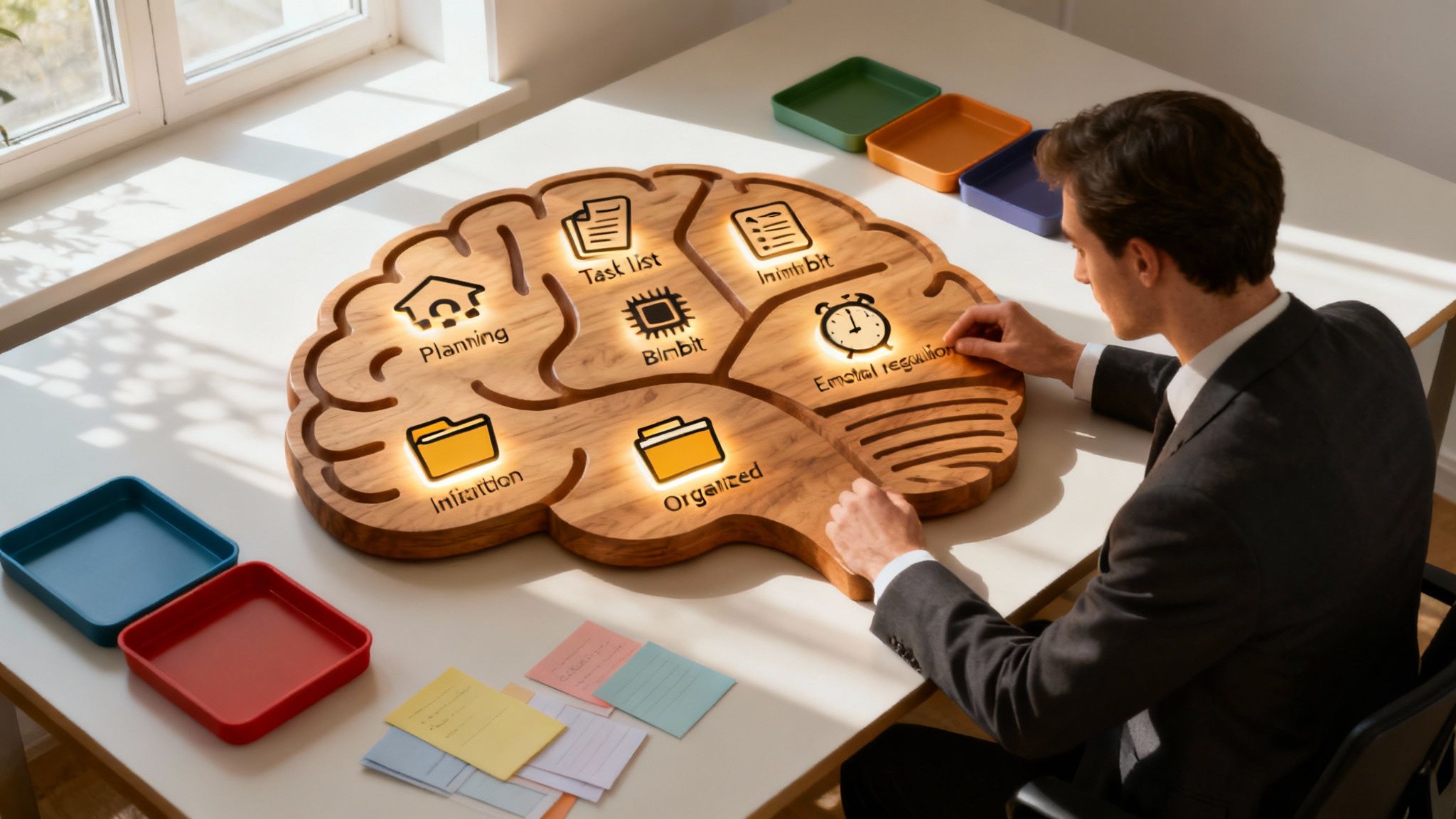When we think of someone with ADHD, having an attention deficit is one of their obvious challenges. But there's another equally challenging aspect of attention-deficit/hyperactivity disorder that often gets overlooked: a deficit in motivation.
And if you have ADHD and you've experienced motivation's vanishing act firsthand, then you know what it feels like — sluggishness, boredom, and apathy.
But to others, an unmotivated ADHDer may just seem lazy. In reality, it has nothing to do with work ethic or willpower. These misconceptions are harmful, reinforcing ADHD stereotypes and creating a sense of helplessness among ADHDers.
Motivational deficits can be incredibly challenging. It’s disheartening when you want to accomplish something only to struggle with finding the motivation to start. Fortunately, there are ways to hack your ADHD brain and boost your motivation. There are lots of acronyms and TikTok trends out there to increase motivation, but this article focuses on one method in particular: the INCUP method.
The INCUP method leverages the five pillars of motivation: interest, novelty, challenge, urgency, and passion. Let's dive into each step and explore why it works especially well for ADHD brains. Then, you'll be on your way to overcoming motivational obstacles and achieving your goals.
Too long; didn’t read
- People with ADHD tend to struggle more with self-motivation compared to neurotypical peers due to differences in brain chemicals.
- INCUP is a motivation hack that stands for... interest, novelty, challenge, urgency, and passion.
- ADHDers are more motivated to start and finish a task when they're genuinely interested in it or passionate about it, it's new to them, it's challenging, or it's time-sensitive.
Why do people with ADHD struggle with motivation?
ADHD – and the motivation deficit that often comes with it – originates in the brain. People with ADHD are quite literally wired differently, with the most significant differences involving two key neurotransmitters: dopamine and norepinephrine.
- Dopamine is the brain’s reward center. It’s responsible for feelings of pleasure, satisfaction, and motivation.
- Norepinephrine is like dopamine’s less glamorous cousin. It plays a role in arousal, attention, and motivation. (It's also the precursor to adrenaline!)
What do these chemicals have in common?
- They both drive motivation.
- ADHD brains have lower levels of both.1,2
Due to the deficiency in dopamine and norepinephrine, kids and adults with ADHD often face challenges with their executive functioning skills. These skills allow us to plan, organize, initiate, and complete tasks.
When you struggle with executive function, you have what's called "executive dysfunction," and as a result, your motivation can take a hit.
How to use INCUP to motivate someone with ADHD
Coined by William Dodson, the term INCUP stands for interest, novelty, challenge, urgency, and passion. According to Dodson, the letters represent the five pillars of motivation, specifically for people with ADHD.
I - Interest
Due to the lower levels of dopamine, ADHDers have what’s known as an "interest-based nervous system." To best understand this concept, let's first look at how a task's level of importance can affect motivation levels in people without ADHD:
For neurotypicals, the significance or importance of a task can serve as a powerful motivator. The more important something is, the more likely they are to find the self-motivation needed to complete the task. ADHD brains don't always function that way.
Unlike neurotypical individuals, ADHDers are not primarily motivated by a task's supposed importance. Instead, their brains crave high stimulation and immediate rewards.3 And what's something that can satisfy this craving?
Genuine interest.
Engaging in activities that are interesting or enjoyable provides the brain with a surge of dopamine. And more dopamine means more motivation.
How to make tasks more interesting
In one study, participants were able to perform a mundane task more effectively when listening to an immersive audiobook at the same time.4 This type of dual-tasking is known as tangential immersion and can be especially helpful for those with ADHD.
Here are more examples for incorporating interest to boost motivation:
- Listen to music while you work
- Reward yourself after meeting “checkpoints” in your task progress
- Pair a boring task with an exciting one (ex: sort your laundry while you watch the newest episode of your favorite show!)
- Use gamification techniques (For example, you can create a point system to incorporate some friendly competition. You can even compete against yourself!)
- Try body doubling
N - Novelty
When something has "novelty," it means that it's new, unique, or different from what someone is used to. Novel tasks, then, would be those that have an element of newness. Now, ask yourself:
Would you rather do something new and exciting? Or something you've done dozens of times already? For most people, new experiences are naturally more alluring, but this is especially true for ADHDers.
Novel tasks are more interesting and easier to pay attention to. In fact, research has found that children with ADHD perform better with novel material compared to familiar material.5
How to add novelty to boring tasks
The entire task doesn't need to be brand new for it to be considered novel! Let's take exercise for example: Maybe you've walked on the treadmill dozens of times and it's starting to get old. Try adding a book into the mix!
But... even with a book, walking on a treadmill can get pretty monotonous. If I were to stick to the same routine every time I went to the gym, I'd eventually lose my motivation to work out altogether!
So to incorporate novelty, I now use the treadmill as a warm-up before jumping into my novel exercise of choice: boxing. Novelty is an inherent part of boxing – different classes, instructor rotations, and diverse playlists. Plus, new combinations are called in each round, which helps keep it fun and new every time.
More examples of motivation-enhancing novelty
- Can’t focus at your work desk at home? Is it nice outside? Do your work outside today.
- Getting overwhelmed with your cluttered desk space? Work from a coffee shop this afternoon.
- Tired of your morning routine? Splurge on some new coffee beans to add to your morning cup!
- Getting irritated and distracted by the guy in the cubicle next to you who constantly sighs and sniffles? Add novelty by listening to background noise or ambient sounds through your headphones.
C - Challenge
Studies consistently show that kids with ADHD often lose interest in easy or mundane tasks, making them less motivated to start or finish them.3 Why?
Their brains are prone to boredom! In order for them to want to do something, they need stimulation and engagement. And you can make a task stimulating and engaging by making it challenging.
On the flip side, simple tasks can get boring quickly for them, which can be especially frustrating since they're more prone to boredom. To keep them motivated and engaged, it's important to give them tasks that match their level of challenge.
Motivational ways to challenge yourself
Interest alone isn’t enough to spark motivation; you also have to feel mentally stimulated. However, tasks shouldn't be so demanding to the point of becoming overwhelming.
According to a study, people with ADHD reported feeling more motivated when engaging in activities that gave them a sense of accomplishment or pride.7
Tasks should be appropriately challenging, but achievable.
More ways to make tasks more challenging
- Break large tasks up into smaller steps and give yourself a time limit for each task. Ready, set, go!
- Create contests at work: Who engaged the most on the company Slack channel this month? Who responded to the most emails today? (Obviously, this one should be based on percentage and not the actual count)
- Set performance goals for yourself. (Remember, it should be challenging, but attainable.)
U - Urgency
ADHD and procrastination often go hand-in-hand. There are several reasons ADHDers might procrastinate—feelings of overwhelm, perfectionism, poor time management—but more importantly, procrastination behaviors are also directly linked to dopamine and norepinephrine.
You know that rush of adrenaline you feel when you've put off writing that paper until the last minute, and now you're trying to beat the clock and submit it before the deadline? (...Just me?) Procrastination leads to urgency, and urgency leads to adrenaline, and that rush of excitement can become addicting. (Yes, you can be addicted to procrastinating!)
What's my point?
Motivation doesn't come easily for an ADHDer in a non-urgent situation, but you'd be surprised at how much they could get done if you add a sense of urgency to the mix.
How to create a sense of urgency to spark motivation
You don’t necessarily need external deadlines or pressure to spur you into action. Instead, you can hack your ADHD brain by artificially creating that same sense of urgency.
Examples for creating more urgency to complete your tasks
- Use the Pomodoro method.
- Give yourself a deadline and write reminders everywhere (sticky notes, Google calendar, texts to yourself, etc.).
- Find a coworking partner who can hold you accountable to your goals and tasks.
- Start a task right before a favorite TV show. (This has that same vibe as cleaning your house right before someone comes over!)
P - Passion
There are two primary types of motivation: extrinsic and intrinsic. Extrinsic motivation is tied to an external reward or benefit, while intrinsic motivation is driven by your own desires. In other words, you're not doing a task because you need to, but because you want to.
To increase intrinsic motivation, there are three factors to consider:6
- Autonomy: Having a choice allows us to feel free and independent.
- Competence: Being good at something offers a sense of accomplishment.
- Relatedness: Doing things that make us feel connected with other people provides a sense of purpose.
Research studies have found that people with ADHD tend to score higher on extrinsic motivation and lower on intrinsic motivation. Basically, if a task isn't intrinsically motivating, ADHDers may need more frequent and immediate external rewards.5
Given that the ADHD brain is interest-driven, fostering intrinsic motivation is important if they want to get things done.
How to cultivate passion (despite the boring tasks)
ADHD isn't just about attention deficits. In fact, hyperfocus, the opposite of inattention, is a common ADHD experience. When ADHDers are passionate about something, they can become totally absorbed in it. But even if a task isn't inherently captivating, we can use our personal goals to ignite passion and drive.
Let your passions drive you: examples!
- Visualize the outcome. What do you see yourself doing or feeling when you complete the task?
- Look at the bigger picture. What’s the purpose of the task? Who is it affecting?
- Reflect on your past accomplishments related to the task. Weren’t you so proud of yourself when you paid your water bill on time last month?
- Connect the activity to a long-term goal. If you do this, what else will you be able to achieve?
- Offer to mentor someone else. The best way to learn something is to teach it. At least, that’s what they say.
Final thoughts
If you have ADHD, feeling motivated can be a struggle, but that doesn’t mean it’s impossible. On the contrary! You can boost your motivation by using the INCUP method.
ADHDers are motivated when tasks have some element of interest, novelty, challenge, urgency, and passion. Adding just one of those factors to a task can instantly help motivate you and improve your focus and productivity.
-
Sources
1 Clin Child Fam Psychol Rev | Review of the Evidence for Motivation Deficits in Youth with ADHD and Their Association with Functional Outcomes (2018)
2 Curr Dev Disord Rep | Neurobiology of ADHD: A Review (2019)
3 Child Psychiatry Hum Dev | Impact of Motivation on Selected Aspects of Attention in Children with ADHD (2021)
4 Journal of Consumer Research | Tangential Immersion: Increasing Persistence in Boring Consumer Behaviors (2022)
5 Master of Applied Positive Psychology (MAPP) Capstone Projects | ADHD, Willpower, and Interest: A Positive Approach (2020)
6 Journal of Attention Disorders | Studying Motivation in ADHD: The Role of Internal Motives and the Relevance of Self Determination Theory (2022)
7 Eur Child Adolesc Psychiatry | What motivates individuals with ADHD? A qualitative analysis from the adolescent’s point of view (2017)









